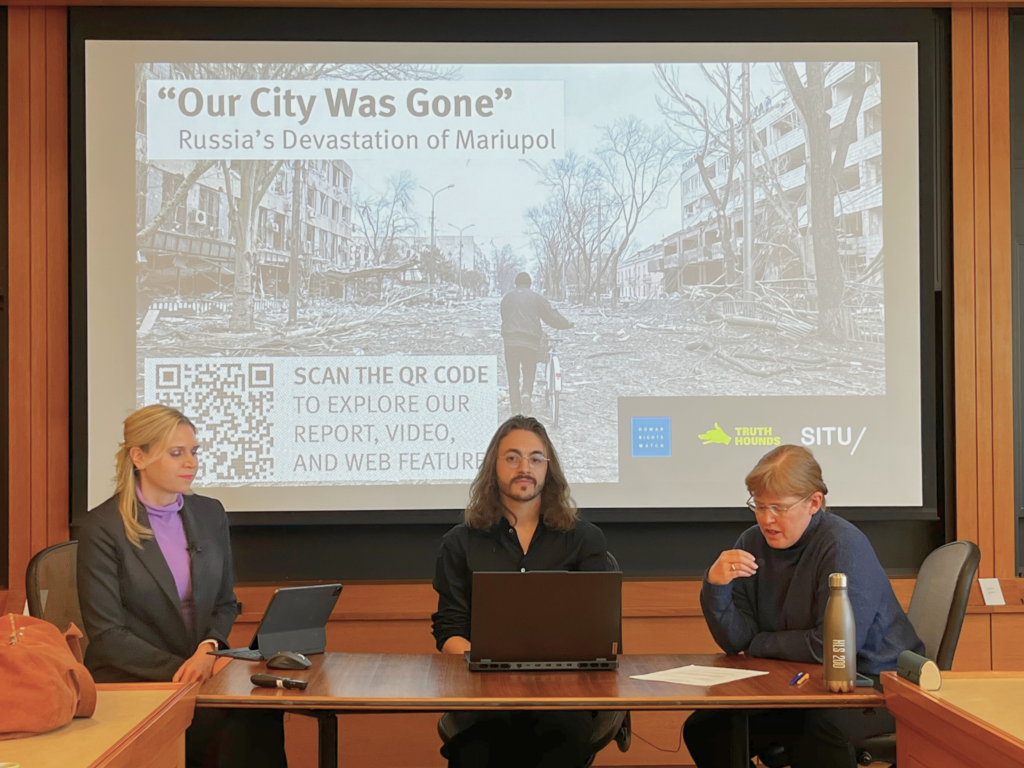This piece was originally published on the Humanitarian Disarmament website.
Immediately upon the Russian full-scale invasion of Ukraine, Mariupol became a focal point of the war as Russia’s grip tightened around the coastal city. About 540,000 people resided in Mariupol before the Russian armed forces attacked, but as the bombardment continued, the number of residents dwindled, due to death and displacement. On May 20, 2022, after a battle of three months, the city fell, and Russia claimed control.
Yet, within this shattered landscape, amidst the ruins, a defiant spirit flickered—a resolve to defy oblivion, and to seek justice. As Human Rights Watch researchers began collecting witness testimony of the attacks from people who managed to escape, they heard not only story after story of “apocalyptic destruction,” but also memories of the “vibrancy and beauty” of Mariupol as a cultural hub and seaside destination before Russia’s full-scale invasion.

Against this backdrop, Human Rights Watch, SITU Research, and Truth Hounds partnered to document the aftermath of the assault. They sought to promote accountability for perpetrators, preserve the history of a city that strives not to be forgotten, and bolster advocacy against the use of explosive weapons in populated areas.
Their collaboration led to an impressive 224-page report, 3-D reconstruction of the damage, a 20-minute video, and an organigram of the command structure, posted on the Human Rights Watch website.
On April 9, 2024, researchers from Human Rights Watch and SITU Research presented their findings at Harvard Law School. The panel was composed of Ida Sawyer, crisis and conflict director at Human Rights Watch, and Evan Grothjan, spatial researcher with SITU, and was moderated by Bonnie Docherty, lecturer on law at Harvard Law School’s International Human Rights Clinic and director of its Armed Conflict and Civilian Protection Initiative.
Sawyer explained that the organizations conducted 240 interviews with witnesses, government officials, and others and amassed extensive open-source data on the attacks. Grothjan described how SITU Research drew on this information to create digital reconstructions of damaged buildings.

Their presentation highlighted the breadth and depth of the destruction from the use of explosive weapons by Russian forces in Mariupol. The organizations’ investigation revealed damage to or destruction of 93 percent of apartment buildings in the city center, all 19 hospitals in the city area, and 86 out of 89 schools and universities. The full scale of the damage was corroborated through digital reconstructions of the affected buildings, conducted by Grothjan’s team at SITU Research. Through a combination of street view maps, digital reconstruction software, and knowledge of Russian architecture, the SITU team was able to paint a picture of the extent of the destruction of architecture in Mariupol.
The final report also details 14 attacks on various targets including a supermarket, residential areas, and cultural landmarks. In these cases, researchers found limited evidence of military objectives, suggesting the attacks may amount to unlawful targeting of civilians or civilian objects.
The organizations also determined that at least 8,000 people died as a result of Russia’s assault on Mariupol. They based this finding in part on satellite imagery and drone footage of new graves. Sawyer said this number was a conservative estimate, with the true toll likely being much higher.
The organizations sought to assign responsibility for this harm to Russian units and commanders. They scrubbed social media for posts and videos of the attacks, read obituaries of Russian soldiers killed in Mariupol, and reviewed footage of medal and award ceremonies commending Russian soldiers for their participation in the carnage. Through this research, the organizations identified 17 Russian military units operating in Mariupol and named 10 senior commanders, warranting investigation for potential war crimes.
Sawyer said she hopes the project will help bring justice and reparations to victims who have expressed a strong desire for accountability—including through universal jurisdiction claims and other international and national prosecutions, building on the evidence collected in the report. In addition, the documentation will help preserve evidence of a city the Russians are currently rebuilding in a Russified style. Finally, the work of Human Rights Watch, SITU Research, and Truth Hounds should provide added impetus for universalization and implementation of the Explosive Weapons Declaration, which seeks to increase the protection of civilians from the use of such weapons in populated areas.